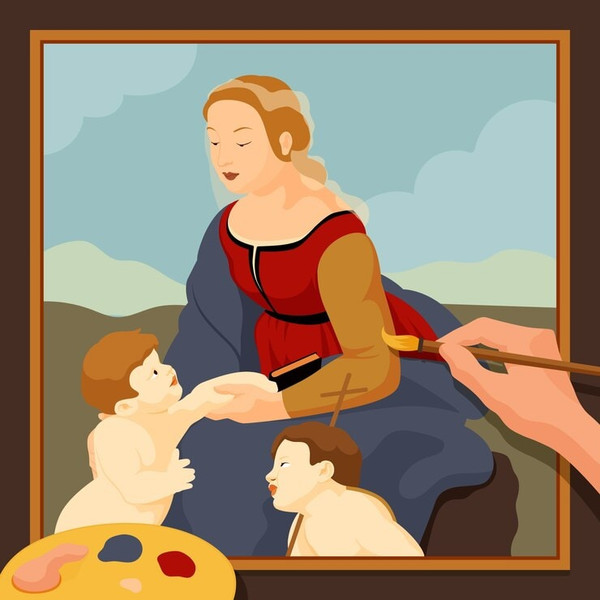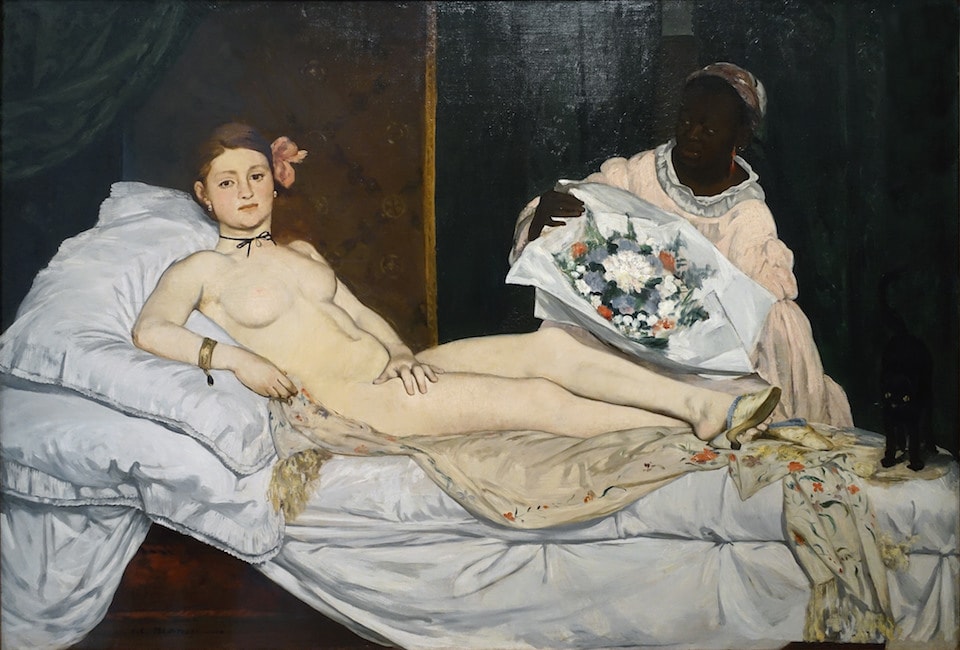15 Famous Paintings of Women: A Journey Through Art and History
Posted by MintSuper Art on 13th Jan 2025
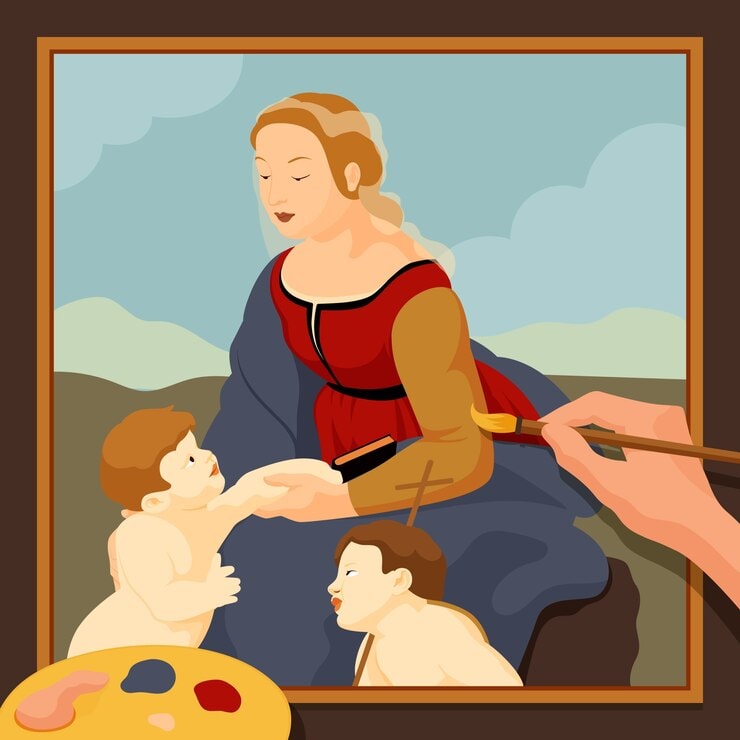
Throughout the centuries, famous paintings of women have remained one of the most enduring and captivating themes in art. These works reflect not only the artist’s skill but also the cultural, social, and personal narratives of their time. From Renaissance masterpieces to modern interpretations, famous paintings of women encompass a rich diversity of styles, themes, and emotions. They tell stories of beauty, power, vulnerability, and strength—capturing the essence of the feminine spirit in ways that resonate across generations.
Most Famous Paintings of Women in History and Their Artist
Art history is filled with iconic portrayals of women, each revealing a unique perspective on femininity, culture, and emotion. These iconic paintings, created by some of the world’s most famous artists, offer a glimpse into the evolving representation of women over time. Below are some of the most renowned paintings that have left an indelible mark in art history
Mona Lisa by Leonardo da Vinci, 1503 - 1505
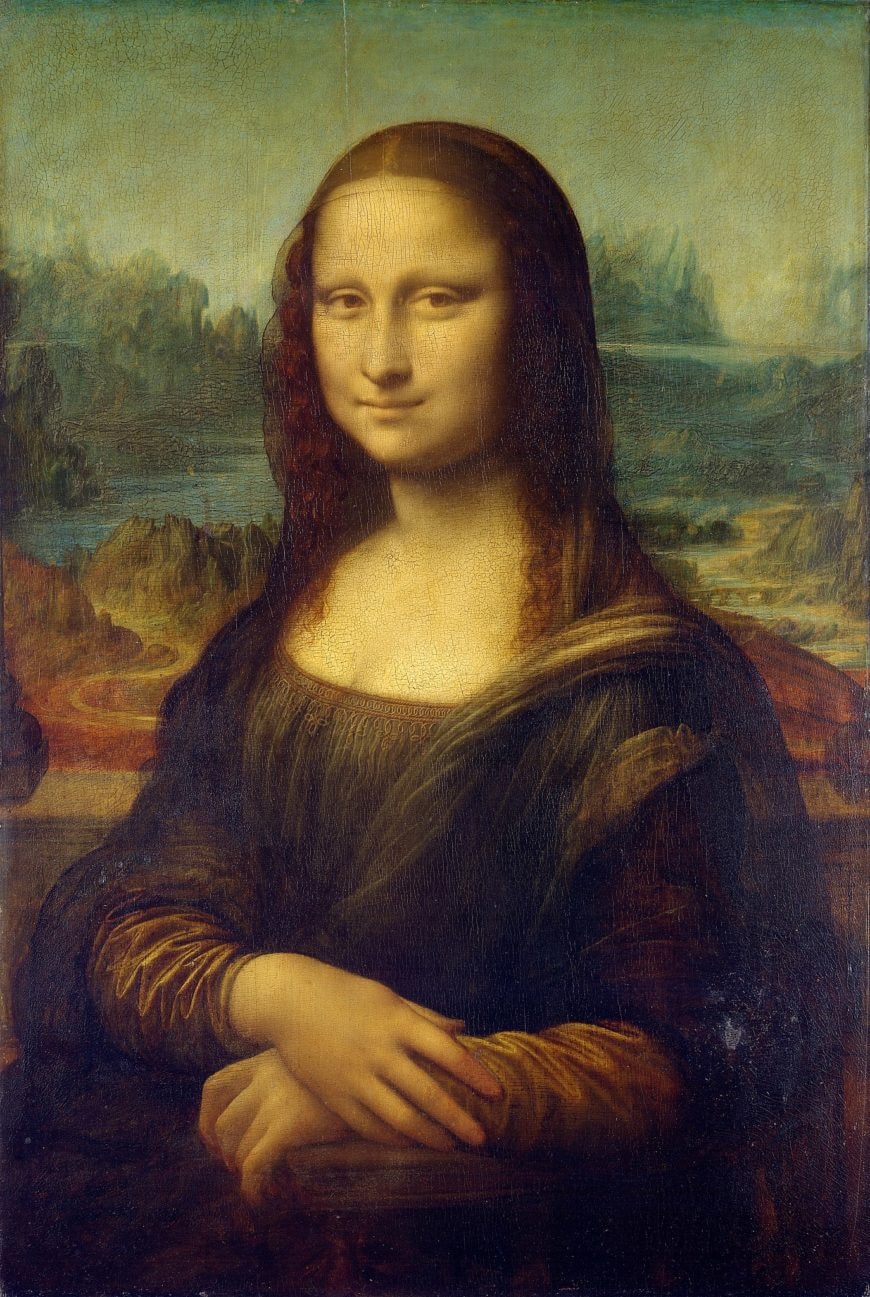
The Mona Lisa, painted by Leonardo da Vinci, is one of the most celebrated works in art history. The subject of this iconic portrait, Lisa Gherardini, was a Florentine woman believed to be the wife of a wealthy merchant. Her enigmatic expression, often described as a subtle smile, has intrigued viewers for centuries, making the painting a symbol of mystery and beauty. What sets this masterpiece apart is da Vinci's revolutionary use of techniques like sfumato, which creates soft transitions between colors and tones, giving the portrait its lifelike quality. The work’s cultural significance lies in its universal appeal, transcending time and geography. Housed in the Louvre Museum, this painting continues to captivate millions with its intricate details and profound emotional depth, securing its place as a timeless representation of feminine grace.
Girl with a Pearl Earring by Johannes Vermeer, 1665
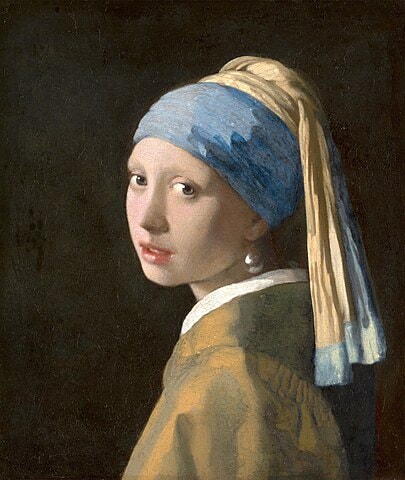
Often referred to as the "Mona Lisa of the North," Girl with a Pearl Earring by Johannes Vermeer is an extraordinary portrayal of elegance and mystery. The identity of the young woman remains unknown, adding an air of intrigue to the painting. Her gaze, turned toward the viewer with wide, curious eyes, creates an intimate connection that has fascinated art enthusiasts for centuries. Vermeer’s masterful use of light and color brings the portrait to life. The soft glow on the girl’s face contrasts beautifully with the dark background, highlighting the luminous pearl earring—a central focal point. The earring itself has been interpreted as a symbol of wealth or purity, adding depth to the work’s significance. This captivating piece is more than just a portrait; it’s a study of light, beauty, and human emotion that continues to inspire wonder.
The Birth of Venus by Sandro Botticelli, mid 1480s
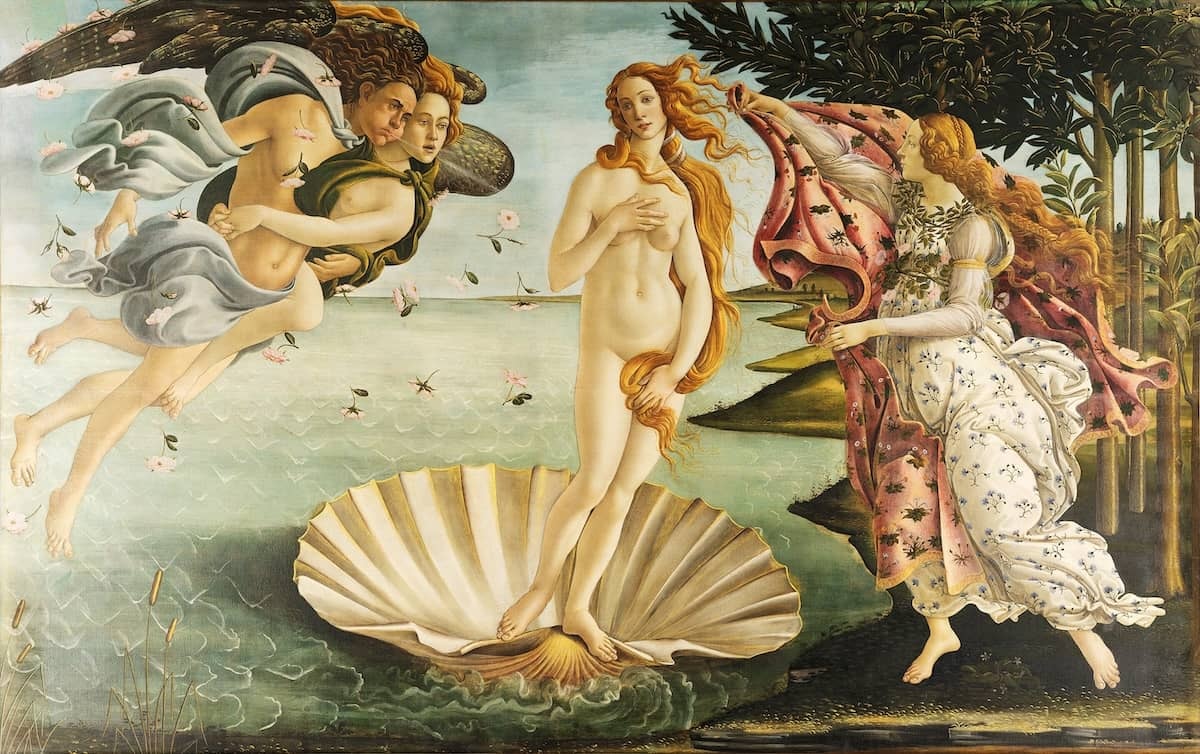
Sandro Botticelli’s The Birth of Venus is a mesmerizing celebration of mythological themes and Renaissance ideals. The painting depicts the goddess Venus emerging from the sea upon a shell, a scene inspired by classical mythology. This masterpiece reflects the cultural context of its time, blending Greek and Roman influences with the emerging humanist philosophy of the Renaissance. Venus is portrayed as the embodiment of idealized beauty, with her flowing golden hair and graceful pose symbolizing purity and divinity. Botticelli’s use of soft, flowing lines and delicate colors enhances her ethereal presence. The surrounding figures, including Zephyrus, the wind god, and a nymph offering a robe, emphasize the goddess’s central role as a timeless figure of love and beauty. This iconic work continues to captivate audiences, serving as a testament to the enduring allure of classical mythology in art.
Lady with an Ermine by Leonardo da Vinci, 1489–1491
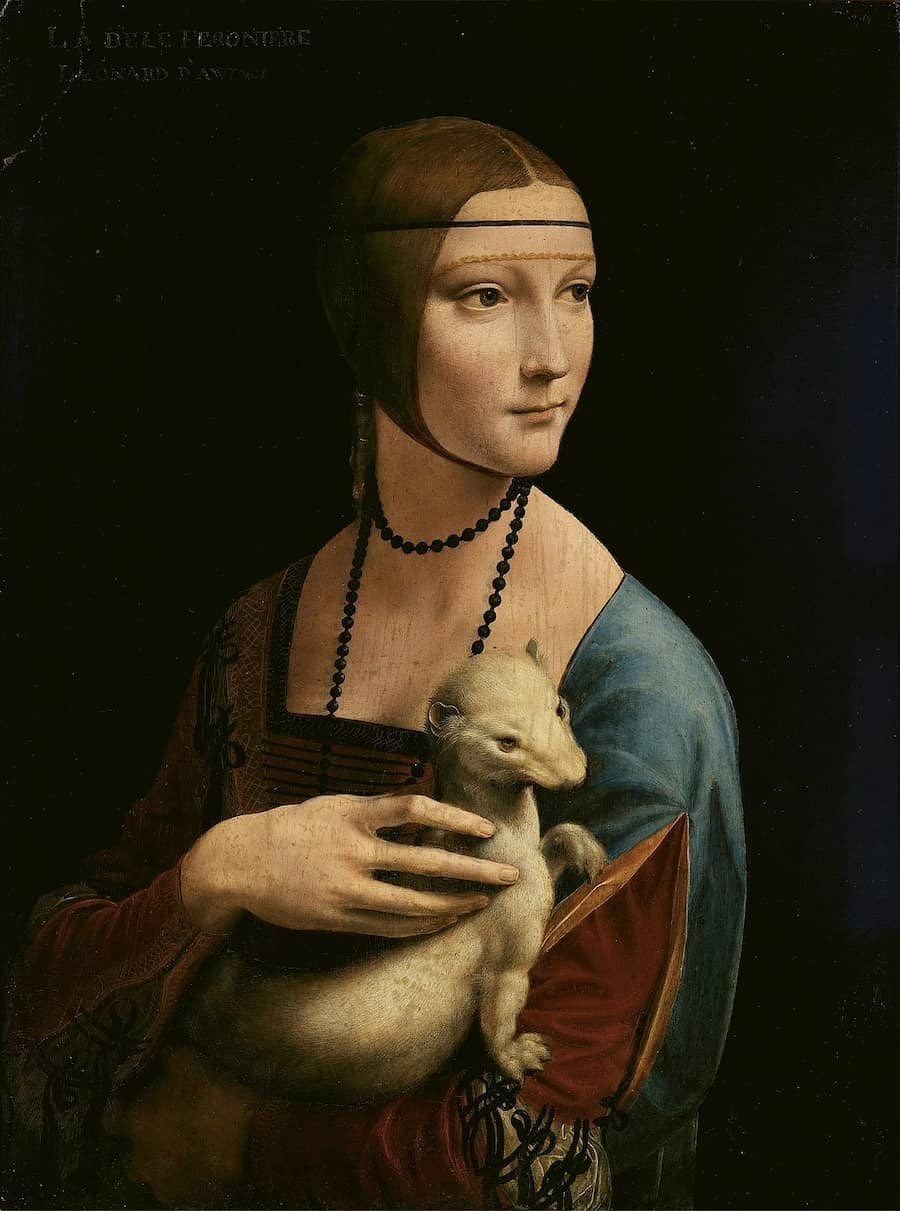
Lady with an Ermine is a captivating portrait of Cecilia Gallerani, a young woman known for her intelligence and beauty. Gallerani was the mistress of Ludovico Sforza, the Duke of Milan, who commissioned the painting. Her calm yet confident expression reflects not just her outward appearance but also her intellectual charm, which was celebrated in her time. The ermine, held delicately in her arms, is rich in symbolism. It is often associated with purity and virtue, but in this context, it may also represent Ludovico Sforza, whose emblem was the ermine. The interplay between the subject and the animal gives the painting a layered depth, blending personal and symbolic narratives. Leonardo Da Vinci’s attention to detail and mastery of light and shadow make this work a remarkable example of Renaissance portraiture, leaving a lasting impression on viewers today.
Olympia by Édouard Manet, 1856
The Olympia, painted by Edouard Manet, sparked significant controversy when it was first exhibited due to its bold and unapologetic portrayal of a reclining, nude woman. Unlike traditional depictions of idealized femininity, this painting presented a modern and confrontational image of a courtesan, gazing directly at the viewer with confidence. The work challenged societal norms and traditional artistic conventions, making it a powerful commentary on class, gender, and morality in 19th-century France. In modern interpretations this painting is a groundbreaking representation of femininity, emphasizing individuality and agency rather than idealized beauty, cementing its status as a pivotal piece in the transition to modern art.
Arrangement in Grey and Black No. 1 (Whistler’s Mother) by James McNeill Whistler, 1871
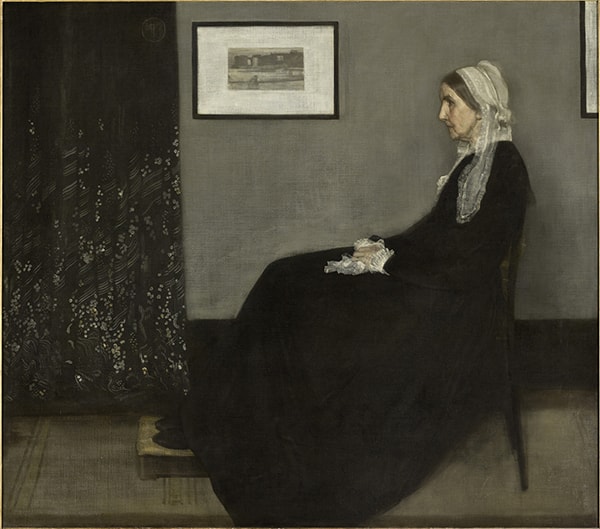
Whistler’s Arrangement in Grey and Black No. 1, by James McNeill is widely known as Whistler’s Mother and is a profound symbol of maternal dignity and quiet strength. The painting’s restrained use of grey and black tones emphasizes form and balance, reflecting Whistler’s focus on composition over sentimentality. This approach connects the work to early modern art trends and minimalism, showcasing simplicity as a powerful artistic statement. Celebrated as a universal image of motherhood, the piece transcends its context to resonate with viewers worldwide. Its portrayal of a seated, composed figure exudes timeless grace and reverence, making it an iconic contribution to American art history.
Gabrielle d’Estrées and One of Her Sisters by an unknown artist, 1594
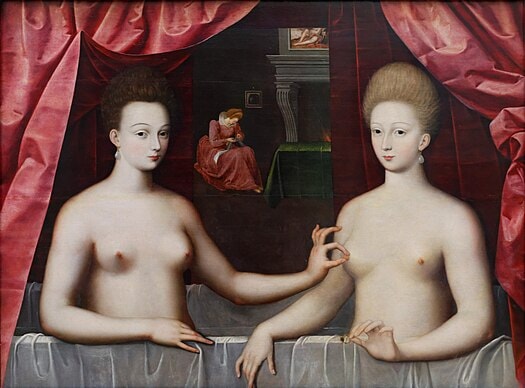
Gabrielle d’Estrées and One of Her Sisters is a strikingly intimate portrait that captures Gabrielle d’Estrées, the mistress of King Henry IV of France, alongside her sister. The painting is most notable for its suggestive gesture, with one sister pinching Gabrielle’s nipple—a symbol believed to signify fertility and her role as the king’s mistress. This provocative detail, combined with Renaissance symbolism, adds meaning to the work. The ring held by Gabrielle represents her engagement to King Henry IV, while the bath reflects themes of purity and preparation, often linked to maternity or marriage. Created during the late Renaissance, the painting offers a glimpse into the complex interplay of personal relationships and societal expectations of the era. Its unconventional composition and symbolism continue to intrigue viewers, making it a fascinating commentary on love, power, and intimacy in the royal court.
Portrait of Adele Bloch-Bauer by Gustav Klimt, 1907
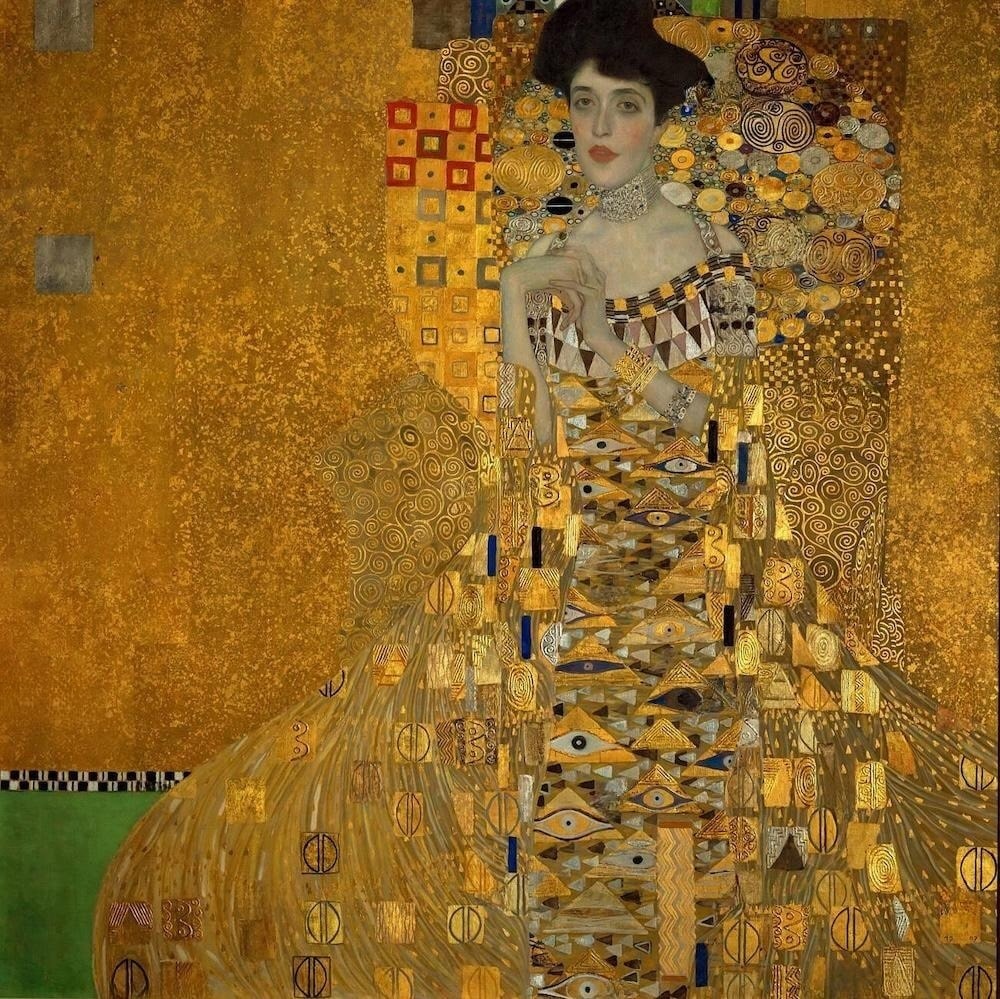
Portrait of Adele Bloch-Bauer by Gustav Klimt often called the "Woman in Gold," is a stunning example of the artist’s signature style, intricate gold detailing and mosaic-like patterns. Klimt’s masterful use of gold leaf and bold textures imbues the painting with a sense of opulence, while Adele’s poised expression reflects her elegance and mystery. Adele Bloch-Bauer, a prominent Viennese socialite, served as Klimt’s muse, and their connection adds a layer of intimacy to this iconic work. Beyond its aesthetic brilliance, the painting carries profound historical significance. It was seized by the Nazis during World War II, only to be restituted decades later after a landmark legal battle, symbolizing the restitution of cultural heritage. Representing wealth, femininity, and modernity, Portrait of Adele Bloch-Bauer bridges the ornate traditions of the past with the avant-garde spirit of its time, securing its legacy as one of the most celebrated portraits in art history.
Self Portrait with Thorn Necklace and Hummingbird by Frida Kahlo, 1940
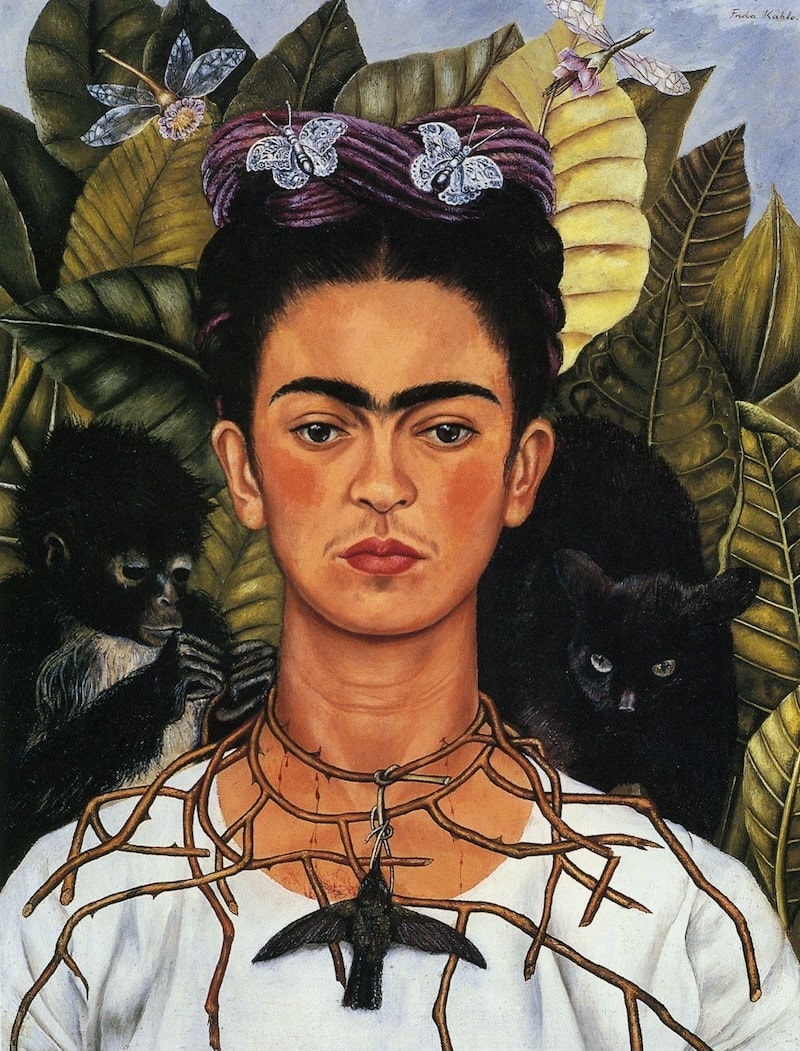
This painting Self Portrait with Thorn Necklace and Hummingbird by Frida Kahlo is a powerful example of how the artist used self-portraiture to explore themes of identity, pain, and resilience. In this work, Kahlo depicts herself with a thorn necklace that pierces her skin, symbolizing the physical and emotional suffering she endured throughout her life. Her Mexican heritage is evident in the vibrant flora and fauna that surround her, blending elements of native folklore and personal symbolism to create a deeply intimate narrative. This painting, along with other notable works like The Two Fridas, showcases Kahlo's ability to channel her health struggles and inner turmoil into art that resonates universally. Her defiant gaze and inclusion of symbolic elements, such as the lifeless hummingbird and a black cat, further reflect themes of loss and survival. As a feminist icon, Kahlo's art challenges traditional notions of beauty and womanhood, celebrating strength in vulnerability and leaving an enduring legacy of empowerment and self-expression.
The Arnolfini Portrait by Jan van Eyck
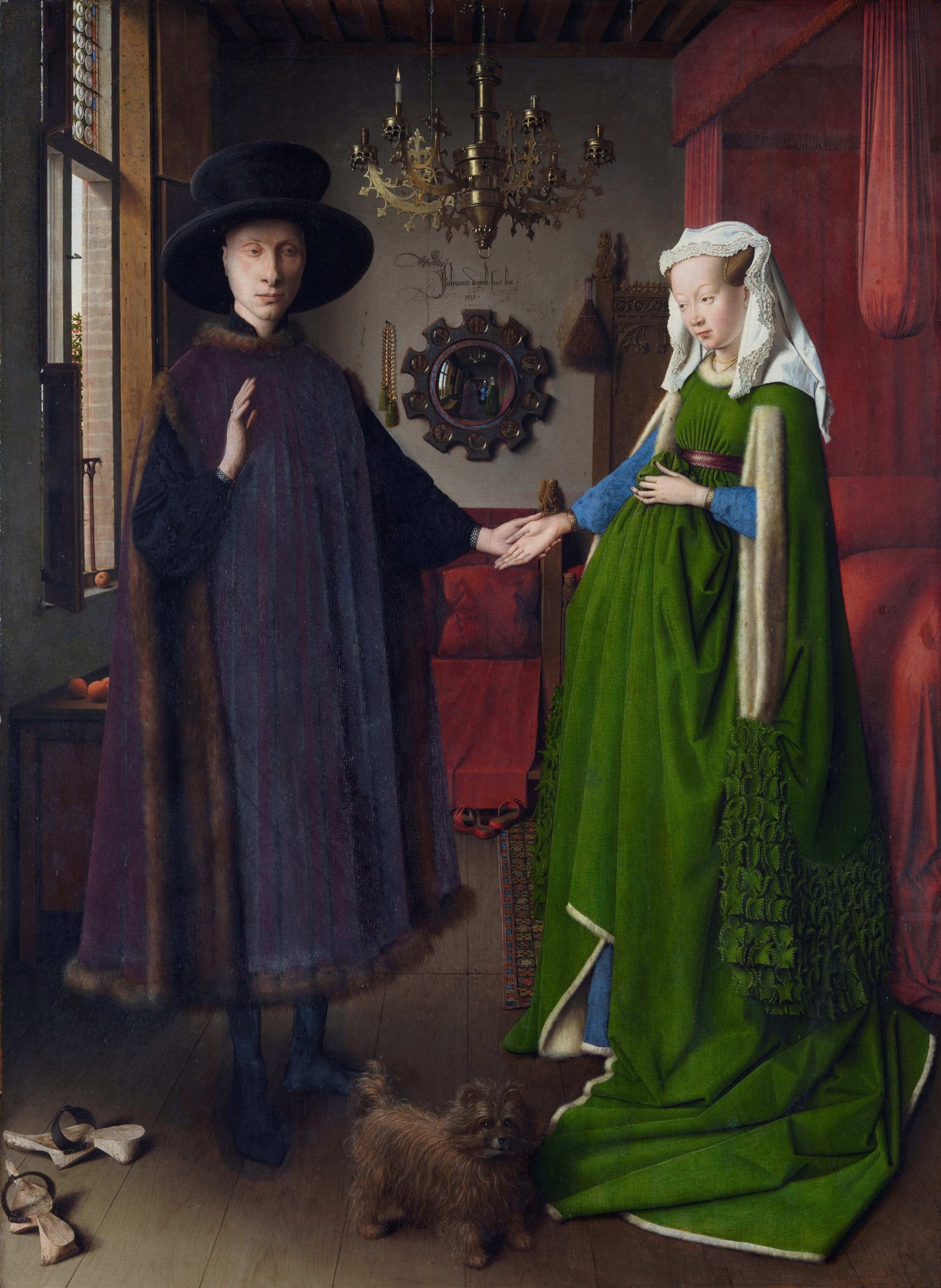
The Arnolfini Portrait by Jan van Eyck is a masterpiece of the Northern Renaissance, portraying Giovanni di Nicolao Arnolfini, a wealthy merchant, and possibly his wife. The painting is celebrated for its intricate details and rich symbolism, which provide insight into the couple’s life and societal status. The small dog at their feet symbolizes loyalty, while the oranges on the windowsill may represent wealth and prosperity. The convex mirror in the background, reflecting two additional figures, is a remarkable feature that adds depth and mystery to the composition.
Van Eyck’s groundbreaking use of oil painting enabled him to achieve an extraordinary level of realism, with textures and lighting rendered in meticulous detail. Scholars have long debated the painting’s meaning, with theories ranging from it being a marriage contract to a memorial for a deceased wife. Regardless of its interpretation, The Arnolfini Portrait remains a fascinating study of realism, symbolism, and the complex narratives embedded in Renaissance art.
Madame X by John Singer Sargent, 1884
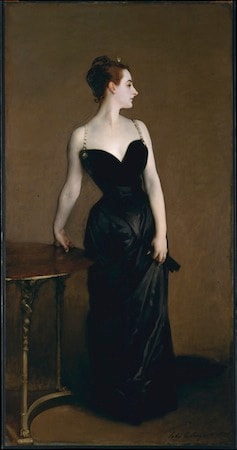
John Singer Sargent’s Madame X caused a sensation when it debuted at the Paris Salon in 1884 due to its bold and unconventional portrayal of Virginie Amélie Avegno Gautreau, a French socialite. The subject’s striking pose, with her head, turned and one strap of her gown initially depicted slipping off her shoulder, was seen as scandalous and provocative for the time. This confident and unapologetic representation of femininity challenged societal norms, sparking admiration and outrage. Sargent use of light and tone heightens the subject’s allure and mystery, with her pale skin contrasting dramatically against the deep black of her gown and the muted background. The painting’s reception initially damaged Sargent’s career in France, prompting him to move to England, where he later thrived as a portraitist. This painting has come to be celebrated as a groundbreaking work, influencing portraiture trends and redefining how confidence and individuality can be conveyed through art.
La Grande Odalisque by Jean-Auguste-Dominique Ingres, 1814
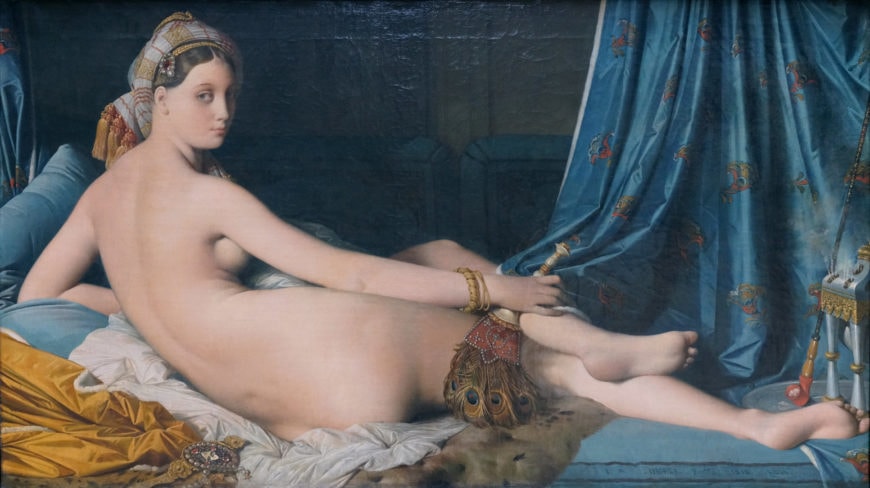
Jean-Auguste-Dominique Ingres’ La Grande Odalisque is a striking portrayal of an exoticized reclining nude, blending neoclassical technique with romantic sensuality. The painting depicts a concubine in a harem, draped in luxurious fabrics and adorned with rich details like a turban and fan, which enhance the sense of opulence and mystery. Ingres exaggerated the proportions of the figure, particularly the elongated back, to create a more graceful and idealized form, prioritizing elegance over anatomical accuracy. The painting was initially criticized for its departure from classical norms, but it later gained recognition for its innovative composition and use of texture to evoke intimacy. The piece reflects the 19th-century European fascination with Orientalism, offering a romanticized and imagined vision of the East. It remains a celebrated example of how Ingres redefined beauty and form, blending tradition with his artistic ideals to create an enduring masterpiece.
Las Meninas by Diego Velázquez, 1656
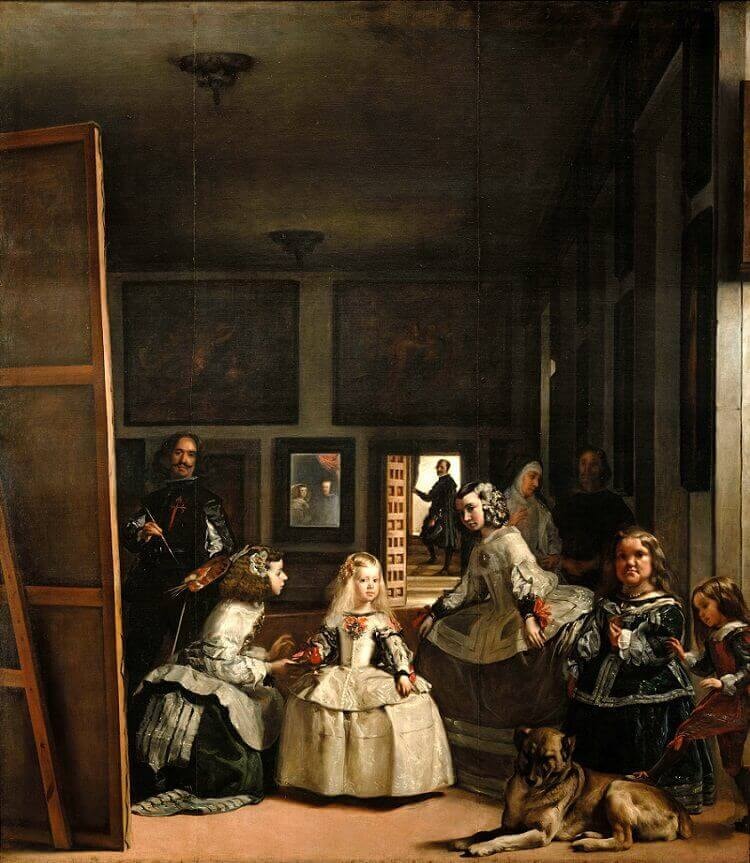
Las Meninas is a masterful and enigmatic painting by Diego Velasquez in 1656. This painting centers on Princess Margarita Teresa, surrounded by her ladies-in-waiting, a dwarf, a dog, and other members of the royal court. The work’s unique composition blurs the lines between portraiture and narrative, placing the young princess as the focal point while simultaneously drawing attention to the artist himself, who appears painting on a large canvas within the scene.
Velázquez’s dual role as creator and participant adds a self-referential layer, inviting viewers to question their relationship with the artwork. The mirror in the background, reflecting the king and queen, further complicates the perspective, suggesting their presence outside the frame or as the subjects of Velázquez’s canvas. By merging realism with symbolic complexity, Las Meninas challenges traditional artistic conventions, encouraging the viewer to engage with its layered meanings and shifting viewpoints. It remains one of the most studied and celebrated masterpieces in Western art.
Portrait of Dora Maar by Pablo Picasso, 1937
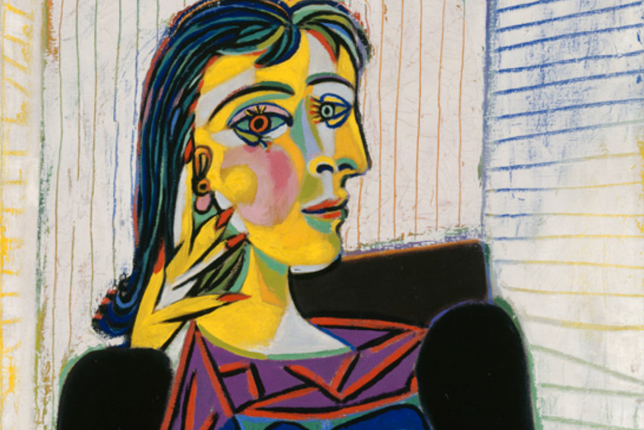
Portrait of Dora Maar by Pablo Picasso is a compelling depiction of his muse and lover, Dora Maar, who was also an accomplished artist and photographer. Known for her strong personality and creative talent, Dora played a significant role in Picasso’s life and work, inspiring some of his most powerful pieces during the late 1930s. In this portrait, Picasso’s Cubist style redefines traditional portraiture, breaking her image into fragmented planes and geometric shapes. This unconventional approach captures the emotional complexity of their tumultuous relationship, blending admiration, tension, and melancholy. The bold colors and distorted forms convey a deeper psychological narrative, symbolizing the multifaceted nature of Dora’s identity and their connection. Through this fragmented yet deeply evocative portrayal, Picasso transformed the art of portraiture, emphasizing emotion and symbolism over literal representation. This painting remains a testament to the intersection of personal relationships and artistic innovation.
Portrait of a Young Woman by Sandro Botticelli, 1485
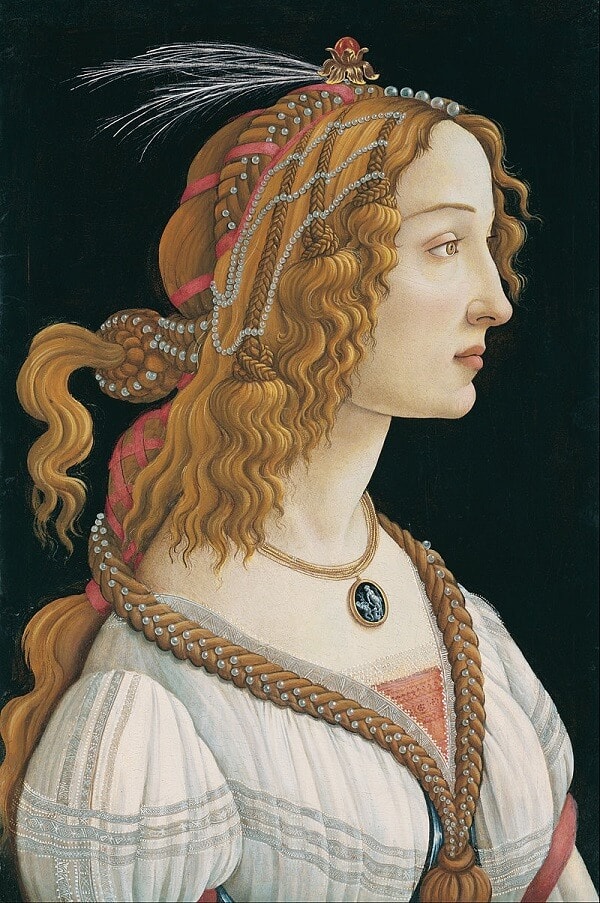
Portrait of a Young Woman by Sandro Botticelli exemplifies his mastery of harmony, grace, and intricate detail. The subject, often linked to Florence's elite circles, reflects Botticelli’s focus on idealized beauty, characterized by delicate features, soft contours, and serene expression. Every element of the painting, from the intricate hairstyle to the flowing drapery, reveals Botticelli's dedication to creating balanced and refined compositions.
The portrait is believed to have connections to the Medici family, a powerful patron of the arts in Renaissance Florence, and embodies the city’s rich cultural heritage. Botticelli’s style draws heavily from classical ideals, blending the influence of ancient Greek and Roman art with the humanist values of the Renaissance. This timeless work is not just a celebration of individual beauty but also a reflection of the intellectual and artistic achievements of Florence during its golden age.
Evolution of Women in Art Across Time Periods
The representation of women in art has evolved dramatically across time, reflecting shifts in cultural values, societal norms, and artistic styles. Each era has contributed uniquely to how women are portrayed, shaping the way femininity, identity, and roles are understood through the lens of art.
Renaissance (15th–16th Century)
During the Renaissance, women were often idealized as symbols of purity, beauty, and virtue. Artists like Botticelli and da Vinci celebrated the human form, inspired by classical ideals. Religious depictions of women, such as the Virgin Mary, emphasized maternal grace and divine beauty, while portraits of noblewomen, like Mona Lisa, showcased their wealth and status. However, women in this era were rarely depicted as independent individuals, often existing in art as muses or allegorical figures shaped by male perspectives.
Baroque (17th Century)
The Baroque period introduced a more dynamic and dramatic portrayal of women, with an emphasis on emotion and movement. Artists like Caravaggio and Artemisia Gentileschi, one of the few prominent female painters of the time, infused their works with realism and intensity. Gentileschi’s works, such as Judith Slaying Holofernes, reflected themes of strength and resilience, often influenced by her personal experiences. Baroque art began to depict women not only as objects of beauty but also as complex characters within dramatic narratives.
19th Century Realism and Impressionism
The 19th century saw a shift towards realism and impressionism, where women were depicted in more everyday settings. Realist artists like Gustave Courbet portrayed working-class women with raw honesty, breaking away from idealized representations. Impressionist painters such as Mary Cassatt, one of the few celebrated female artists of the time, highlighted women’s private and domestic lives, offering a rare, authentic perspective on motherhood and intimacy. This period marked the emergence of women as active participants in art as subjects and creators.
Modern Art (20th Century and Beyond)
In the 20th century, the portrayal of women in art became more diverse and multifaceted, reflecting broader societal changes. Movements like Cubism and Surrealism reimagined the female form, as seen in Picasso’s fragmented depictions and Frida Kahlo’s deeply personal self-portraits. Feminist art in the latter half of the century, led by figures like Judy Chicago and Barbara Kruger, challenged traditional gender roles and celebrated women’s voices and experiences. Today, contemporary art continues to explore themes of identity, equality, and empowerment, with women shaping and being shaped by the evolving world of art. Through these periods, the portrayal of women in art has transitioned from idealized muses to complex, empowered individuals, mirroring the changing roles of women in society and the world at large.
Symbolism and Themes in Famous Paintings of Women
The depiction of women in art is deeply tied to symbolism and themes that reflect societal values, cultural narratives, and individual interpretations of femininity. Across time, these famous paintings have served as mirrors of the evolving roles, identities, and perceptions of women.
Feminine Beauty as an Ideal
Throughout art history, feminine beauty has been a recurring ideal, shaped by the standards of the time. During the Renaissance, artists like Botticelli emphasized symmetry, soft features, and graceful forms, portraying beauty as divine perfection. In contrast, modern art, such as Picasso's Portrait of Dora Maar, fragmented traditional notions of beauty to explore emotional and psychological depth. Over time, art has shifted from depicting beauty as a singular ideal to embracing diverse representations, reflecting changing cultural attitudes.
Women as Symbols of Power and Influence
Women have long been portrayed as symbols of power and influence, often represented as queens, mythological figures, or religious icons. Portraits of monarchs like Queen Elizabeth I convey authority and grandeur, while mythological works, such as Botticelli’s The Birth of Venus, celebrate divine femininity and creation. Religious paintings, including depictions of the Virgin Mary, highlight spiritual purity and maternal strength. These portrayals have immortalized women as central figures in narratives of power, faith, and cultural identity.
Mythology and Allegory
Mythological and allegorical representations of women often carry deeper societal meanings. Paintings like La Grande Odalisque by Ingres use mythological themes to symbolize ideas of exoticism, sensuality, or beauty. Similarly, in Baroque art, figures like Judith from Gentileschi’s Judith Slaying Holofernes reflect themes of justice and resistance. These works not only celebrate mythology but also serve as allegories for human virtues, struggles, and triumphs.
Domestic Life and Social Commentary
Art has frequently depicted women in everyday roles, offering insights into domestic life and broader social commentary. Impressionists like Mary Cassatt focused on intimate moments of motherhood and home life, highlighting the quiet strength and tenderness of women. In the 19th century, realist painters like Courbet portrayed working-class women with raw authenticity, shedding light on societal structures and labor. These works underscore the essential, often overlooked roles women play in society.
The Female Gaze and Feminist Interpretations
Modern times have seen a reimagining of women in art through the female gaze and feminist interpretations. Frida Kahlo’s self-portraits, for example, challenge traditional portrayals by presenting women as complex individuals with agency. Feminist artists in the 20th century used art to critique gender roles, inequality, and societal expectations. This shift has empowered women not just as subjects but also as creators of art that redefines their identity and narrative.
Through these themes and symbols, the representation of women in art has evolved, moving from passive ideals to powerful, multidimensional figures. This evolution reflects not just changes in artistic styles but also the growing recognition of women’s roles, voices, and identities in society.
Conclusion
The famous paintings of women discussed here are more than just artistic masterpieces; they are windows into the cultural, historical, and emotional landscapes of their time. These works have shaped how women are perceived in art, capturing their beauty, strength, and complexity while reflecting broader societal changes. From idealized muses to empowered individuals, the evolution of women in art underscores their enduring influence on the artistic world and human culture. These beautiful paintings not only inspire awe but also invite deeper exploration into the diverse ways art continues to represent the human experience. If these masterpieces have sparked your interest, take a step further into the world of creativity by exploring abstract art or discovering new inspirations in MintSuper Art.

